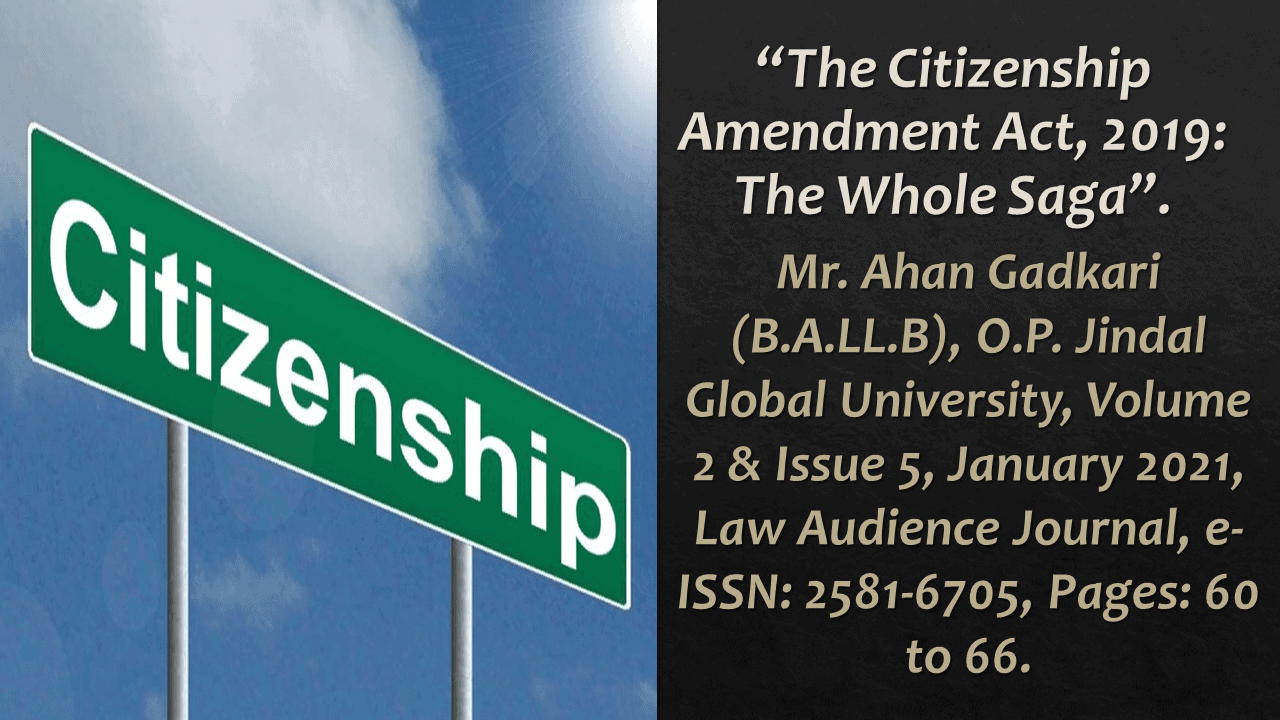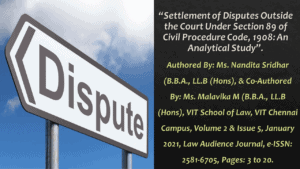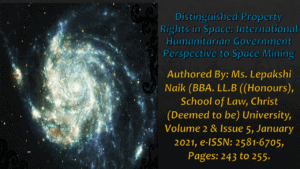Click here to download the full paper (PDF)
Authored By: Mr. Ahan Gadkari (B.A.LL.B), O.P. Jindal Global University.
Click here for Copyright Policy.
Click here for Disclaimer.
I. INTRODUCTION:
The Citizenship Amendment Act, 2019, created such hullaballoo in the country. The said Act faced considerable criticism throughout India. Various scholars claimed that it is unconstitutional[1]. Moreover, it is against the secular spirit of the nation. It divided the whole nation into two groups; the former is against the bill and later supporting the bill. However, due to the misinterpretation and misinformation, it created a havoc situation in the country. In this research paper, the author will try to explain the CAA from scratch and try providing a way forward in this dispute. The Constitution of India provides untrammelled power to the parliament to make laws on citizenship. Article (5-11) deals with the provision of Citizenship in India. Citizenship of an individual in India governs under the Citizenship Act, 1955. It amended the Act, which led to vandalism, tension, and protests across the country.
From the very scratch when the Citizenship Amendment Act, 2019, (hereinafter CAA) presented in the house, it led to severe deliberation and dissatisfaction among the opposition. One of the reasons for the discontent with the CAA is amendment in the existing law relating to Section 2 of the said Act. It amended the definition of illegal migrants and provided that persons belonging to six religious’ communities (Hindu, Buddhists, Sikhs, Parsi, Christian, and Jain) will not be treated as illegal migrants excluding Muslims[2]. This amendment seeks to provide citizenship through the process of naturalization.
It has been alleged that there is no intelligible differentia excluding the Muslims in the Act. Furthermore, if the amendment happened to protect the hapless facing persecution, then why Srilankan Hindus, Myanmar Hindus, excluded in the amendment. Several questions loom over this issue and which led to nation-wide discontent among Muslims, protests, various scholars throughout the world expressed discontent with the CAA. Nevertheless, there is another side of this story, which is about the protesters. They found to be in a perverse pleasure in upsetting the government development by vandalizing the whole nation[3]. The question also looms over the protester when they have the right to protest in the democratic country what led to them performing this kind of brazen Act, which took away the life of others. In this paper, the author will critically analyze the CAA Act, why the government introduced it in the first place, and why the country became rudderless in the past. The author will also focus on the constitutionality of the CAA and try to provide a way forward.
II. CITIZENSHIP AND CITIZENSHIP THROUGH NATURALISATION:
State compromises of population, territory, government, and sovereignty[4]. The significant thing for any state is the population or human resources, and the population of a particular country requires the citizenship of that country. Citizenship explains the relationship between nation and individual. Citizenship provides the necessary rights to the citizen nay some exclusive rights to the citizen viz. the right to vote, freedom of religion, and equal opportunity for public employment. The state must protect the citizens in all possible manners, which utmost require citizenship. Moreover, in this way, citizenship plays a crucial role for any individual. Part II of the Indian Constitution states that Parliament has the right to govern over citizenship. The entry 17 List 1 of the seventh schedule talks about citizenship; hence the union government has exclusive power to make law in this regard.
Part II of the Constitution of India deals with citizenship. The Citizenship Act, 1955, also provides the provision for citizenship. There are four ways to get the Citizenship of India. The four ways in which Indian citizenship may be obtained, i.e., birth, descent, registration, and naturalization. Citizenship through naturalization permits any foreigner to receive the Citizenship of India. Before the CAA, an individual can obtain citizenship by naturalization if he/she has been ordinarily resident in India for 12 years. The whole saga of the CAA related to the government decision for amending the said provision which provides citizenship through naturalization.
III. FEATURES OF CAA (CITIZENSHIP AMENDMENT ACT 2019):
The Act aims to give citizenship to illegal migrants of six religious minorities[5] facing persecution in these three countries Afghanistan, Bangladesh, and Pakistan. CAA extends to those who have been compelled to seek asylum in India as a consequence of religious persecution. Amendment in the citizenship Act 1955, relaxes the naturalization period from 11 to 5 yrs. for specific six religion people viz. Hindu, Sikh, Buddhist, Jain, Parsi, and Christian.
The cut-off date for citizenship is 31 December 2014, which means that the applicant should have entered India on or before that date. They will be deemed to be treated as an Indian citizen after acquiring citizenship from the date of entry. All the cases against them due to illegal migrant status shall be withdrawn. This Act also specifies that persons holding OCI (Overseas Citizen of India) card will lose their status if they violate any local laws. OCI means an overseas citizen of India (Migrant Status) is given to foreign citizens of Indian origin to work and live in India for an indefinite period. Nevertheless, this Act will to not apply six schedule areas, which are tribal areas (Meghalaya, Assam, Mizoram or Tripura[6]). This Act also not extends to the areas under the inner line permit under the Bengal eastern frontier regulation, 1873. Inner lines permit regulated visits of Indians into the regions of Arunachal, Mizoram, and Nagaland.
IV. DEFINITION OF ILLEGAL MIGRANT:
The concept of illegal migrants implies that they have reached India without proper visas and other required documentation. Who entered India with a valid document with a limited period but residing in India after the expiration of the permitted period. If someone caught while violating the norms and found to be illegal migrants may be prosecuted or deported under the Foreigner’s Act 1946.
V. ARGUMENTS AGAINST THE CITIZENSHIP AMENDMENT ACT[7]:
- CAA seems to be explicitly targeting Muslims with no substantial reason at all. The legislation seems to also against secularism, liberalism, equality, and Justice.
- Apart from these six religious minorities groups (Hindu, Buddhists, Sikhs, Parsi, Christian, and Jain) Ahmadiyya Muslims in Pakistan and Hazaras in Afghanistan, Tamil in Sri Lanka are also facing the brutal persecution[8].
- A significant question looms why it is not extended to other neighbouring countries like Sri Lanka and Myanmar. Tamils and Rohingya Muslims came and were staying as refugees in India if the reason had to protect the minorities facing persecution then why Rohingyas excluded from the list[9]. This act also does not focus on the atheist.
- It has been found to violate Article 14. Article 14 demands reasonable classification to be based on i.e., intelligible differentia, and it should be a just, legitimate, and classification must not be arbitrary. The Court also held that religion should not be the ground for discrimination at all. It seems to be violating the basic structure of the constitution. The said act claimed to be anti-secular in nature.
- The CAA failed to understand the predicament of other neighbouring states, and it ignored the brutal genocide happening with the Buddhists in Tibet, which is sharing the border with India.
VI. ARGUMENTS IN THE FAVOR OF THE CITIZENSHIP AMENDMENT ACT[10]:
- It has been alleged by the opposition or various scholars that the government’s decision to implement CAA is such a red herring in this economic condition. However, this argument does not hold water because the bill was first proposed in the Lok Sabha on July 15, 2016. [11]Nevertheless, the bill did not get the majority to pass in the Rajya Sabha.
- It is not violative of Art 14; In the case of Daivid John Hopkins vs. The Union of India[12], Madras High Court held that the union government has the authority to refuse citizenship, and it is an absolute right of the union not fettered by equal protection under art 14. The parliament has the power to monitor citizenship rules in the case of Louis De Raedt & Ors vs. Union of India And Ors[13], the apex court held that Foreigner is confined only to article 21, not to citizenship matter. Also, various cases allow discrimination based on reasonable classification on the basis of intelligible differentia. Moreover, on an important question of whether the government has a reasonable rationale with the object of protecting the prosecuted minorities will be examined by the Supreme Court. However, prima facie answer is in the affirmative for the government.
- It has been stated that the Ahmediyas and Rohingyas may also obtain citizenship in the course of naturalization, provided they have legitimate travel documentation to prove it. Even these six religious people will not get citizenship automatically. They have to fulfill the conditions mentioned in the 3rd schedule of the 1955 Act, such as good character requirements, physical residence, and other such conditions.
- India is a member of the Universal Declaration of Human Rights (UDHR) Convention [14], that is why the government is under a duty to mitigate the concept of statelessness in India. It also argued by the government that CAA would help the people facing persecution in these neighbouring countries, which is again beefing up the concept of human rights protection. However, India did not sign the United Nations Refugee Convention 1951, so; India is not bound to accept the refugee.
- The government clears it for Tamils and other neighbouring nations; if the need arises, the government will deal with it with separate legislation.
- Some states claimed that they would not implement the CAA in their own state. Nevertheless, the Act passed by the central government constituting the central laws cannot be rejected by the state, which is the authority of the central government over the union list.
- Nehru Liaquat pact between India and Pak in 1950 signed to provide security and rights of minorities. It was decided that both countries will provide equal rights to minorities in all places, e.g., in public life in holding public offices, govt services, armed service, and other such services. CAA is also found to be on the heels of the Nehru-Liaquat pact.
VII. CONCLUSION AND A WAY FORWARD:
It is a basic rule of Justice which says, that Justice must not only be achieved, it must always be shown to be accomplished[15]. Mass discontent and protest against the CAA, making the government responsible for clearing the sceptical questions in the minds of masses. The government of the day also failed to answer other questions such as why the CAA does not consider Jews and atheists. The said Act protects only religious persecution but neglecting other persecution issues like political persecution, which is not correct. Equilibrium must be maintained at any cost; the CAA must not, in any form, debilitate the concept of secularism in India. India, being a nation of numerous traditions, a birthplace of faith and defender of oppressed peoples, must not abandon this position and uphold the values of secularism. They have to sustain their faith in democracy and judiciary. Through various cases, it also held by the apex court that fundamental right is inalienable, and no Act, law, or regulation can abridge the fundamental right of a citizen. The government also has to listen to the people’s predicament and provide them with a better understanding of this Act.
Nevertheless, it is the prerequisite duty of the citizen of India to maintain harmony and peace in society. When the issue is now sub-judice before the apex court, one should wait for the verdict. Furthermore, in no circumstance, we can tolerate such vandalism, which happened just a few months ago. In a democratic country, when people can easily criticize and protest against the government, then in no circumstances burning its own home can be a valid option.
[1]‘Over 1,000 academicians release statement in support of CAA’, case (The Hindu, 21 Dec 2019) < https://www.thehindu.com/news/national/over-1000-academicians-release-statement-in-support-of-caa/article30367397.ece> accessed 21 May 2020.
[2] THE CITIZENSHIP (AMENDMENT) ACT, 2019 s 2.
[3] Yuthika Bhargav, ‘Rlys. to recover 80 crore from those who damaged its property in anti-CAA protests’ (The Hindu, 30 Dec 2019) < https://www.thehindu.com/news/national/recovery-to-be-made-from-those-who-damaged-rail-property-during-caa-protests-railway-board-chairman/article30432339.ece>.
[4] Elements of State, ‘Elements and Necessity of the State’ (yourarticlelibrary essay politics) < https://www.yourarticlelibrary.com/essay/politics-essay/state-elements-and-necessity-of-the-state/40323> accessed 20 May 2020.
[5] The Citizenship (Amendment) Bill, 2019, (Prs India) < https://www.prsindia.org/theprsblog/explainer-citizenship-amendment-bill-2019> accessed 20 May 2020.
[6] THE CITIZENSHIP (AMENDMENT) ACT, 2019 s 3.
[7] Report of The Joint Committee on The Citizenship (Amendment) Bill, available at http://164.100.47.193/lsscommittee/Joint%20Committee%20on%20Bill%20to%20amend%20the%20Citizenship%20Act,%201955/16_Joint_Committee_on_Bill_to_amend_the_Citizenship_Act_1955_1.pdf.
[8] Mahesh Jethmalani, ‘Besieged by sophistry: The CAA is constitutionally sound and is unfairly picked apart by its enemies’ (The Times of India, 16 Jan 2020) <https://timesofindia.indiatimes.com/blogs/toi-edit-page/besieged-by-sophistry-the-caa-is-constitutionally-sound-and-is-unfairly-picked-apart-by-its-enemies/> accessed 20 May 2020.
[9] Ashley S Kinseth, ‘India’s Rohingya shame’ (Aljazeera, 29 Jan 2019) < https://www.aljazeera.com/indepth/opinion/india-rohingya-shame-190125104433377.html> accessed 22 May 2020
[10] supra note 7.
[11] The Citizenship (Amendment) Bill, 2019, (Prs India) < https://www.prsindia.org/billtrack/citizenship-amendment-bill-2019> accessed 20 May 2020
[12] AIR 1997, Mad 366
[14] Miloon Kothari, ‘India’s Contribution to the Universal Declaration of Human Rights’ (United nation in India) <http://in.one.un.org/wp-content/uploads/2019/03/Shri-Miloon-Kothari-UDHR-Chapter-12.pdf> accessed on 20 May 2020.
[15] ‘R v SUSSEX JUSTICES ex p McCarthy [1924] 1 KB 256’, John Hemming’s Web Log < http://johnhemming.blogspot.com/2011/04/r-v-sussex-justices-ex-p-mccarthy-1924.html> accessed on 23 May 2020.



